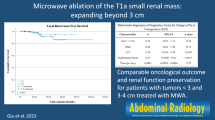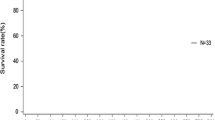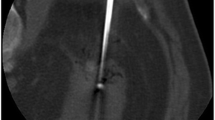Abstract
Purpose
To evaluate the long-term effects of radiofrequency ablation (RFA) of renal masses (RM) and compare them with surgery.
Methods
A total of 203 RM (193 malignant; mean size 30 mm) in 137 patients (95 male subjects; average age 64 years) underwent RFA. Complications and technique effectiveness were evaluated. Overall survival, cancer-specific survival, and disease-free survival were calculated (mean follow-up time 39 months). Predictors for complications, technique effectiveness, and survival were investigated.
Results
Seventeen (8.4 %) adverse events were recorded (2 % major complications). Exophytic development and smaller size were protective against adverse events. Complete ablation was obtained in 87 % RM (93 % ≤3 cm, 89 % ≤4 cm). T1a threshold was a positive predictor for complete ablation and central location a negative one. Three- and 5-year overall survival were 84 and 75 %; cancer-specific survival 96 and 91 %; and disease-free survival 80 and 75 %. Considering only the 79 patients with newly diagnosed renal cell carcinoma, T1a disease stage resulted a positive predictor for both overall survival (87 and 83 % at 3 and 5 years) and cancer-specific survival (100 % at 5 years).
Conclusion
RFA of noncentral small RM is safe and effective, and it provides favorable long-term oncological outcomes. Selection criteria for RFA can also include T1a renal cell carcinoma in patients without surgical contraindications, even though randomized controlled trials are needed to establish the best treatment.




Similar content being viewed by others
References
McGovern FJ, Wood BJ, Goldberg SN, Mueller PR (1999) Radio frequency ablation of renal cell carcinoma via image guided needle electrodes. J Urol 161:599–600
Clark TW, Millward SF, Gervais DA, Technology Assessment Committee of the Society of Interventional Radiology et al (2009) Reporting standards for percutaneous thermal ablation of renal cell carcinoma. J Vasc Interv Radiol 20(7 suppl):S409–S416
Volpe A, Cadeddu JA, Cestari A et al (2011) Contemporary management of small renal masses. Eur Urol 60:501–515
Gervais DA, McGovern FJ, Arellano RS et al (2003) Renal cell carcinoma: clinical experience and technical success with radio-frequency ablation of 42 tumors. Radiology 226:417–424
Silverman SG, Gan YU, Mortele KJ et al (2006) Renal masses in the adult patient: the role of percutaneous biopsy. Radiology 240:6–22
Millet I, Doyon FC, Hoa D (2011) Characterization of small solid renal lesions: can benign and malignant tumors be differentiated with CT? AJR Am J Roentgenol 197:887–896
Patel AR, Lee BH, Campbell SC et al (2011) Bilateral synchronous sporadic renal tumors: pathologic concordance and clinical implications. Urology 78:1095–1099
Veltri A, Grosso M, Castagneri F et al (2009) Radiofrequency thermal ablation of small tumors in transplanted kidneys: an evolving nephron-sparing option. J Vasc Interv Radiol 20:674–679
American Urological Association (AUA) (2009) Guideline for management of the clinical stage 1 renal mass. http://www.auanet.org/common/pdf/education/clinical-guidance/Renal-Mass.pdf
Ljungberg B, Cowanb NC, Hanbury DC et al (2010) EAU guidelines on renal cell carcinoma: the 2010 update. Eur Urol 58:398–406
Escudier B, Eisen T, Porta C (2012) Renal cell carcinoma: ESMO clinical practice guidelines for diagnosis, treatment and follow-up. Ann Oncol 23(suppl 7):vii65–vii71
Best SL, Park SK, Yaacoub RF et al (2012) Long-term outcomes of renal tumor radio frequency ablation stratified by tumor diameter: size matters. J Urol 187:1183–1189
Zagoria RJ, Pettus JA, Rogers M et al (2011) Long-term outcomes after percutaneous radiofrequency ablation for renal cell carcinoma. Urology 77:1393–1399
Nadu A, Kleinmann N, Laufer M et al (2009) Laparoscopic partial nephrectomy for central tumors: analysis of perioperative outcomes and complications. J Urol 181:42–47
Psutka SP, Feldman AS, McDougal WS et al (2013) Long-term oncologic outcomes after radiofrequency ablation for T1 renal cell carcinoma. Eur Urol 63:486–492
Olweny EO, Park SK, Tan YK et al (2012) Radiofrequency ablation versus partial nephrectomy in patients with solitary clinical T1a renal cell carcinoma: comparable oncologic outcomes at a minimum of 5 years of follow-up. Eur Urol 61:1156–1161
Lian H, Guo H, Zhang G et al (2012) Single-center comparison of complications in laparoscopic and percutaneous radiofrequency ablation with ultrasound guidance for renal tumors. Urology 80:119–125
Castle SM, Gorbatiy V, Ekwenna O et al (2011) Laparoscopic and image-guided radiofrequency ablation of renal tumors: patient selection and outcomes. Curr Urol Rep 12:100–106
Atwell TD, Schmit GD, Boorjian SA et al (2013) Percutaneous ablation of renal masses measuring 3.0 cm and smaller: comparative local control and complications after radiofrequency ablation and cryoablation. AJR Am J Roentgenol 200:461–466
Davis K, Kielar A, Jafari K (2010) Effectiveness of ultrasound-guided radiofrequency ablation in the treatment of 36 renal cell carcinoma tumours compared with published results of using computed tomography guidance. Can Assoc Radiol J 63(3 suppl):S23–S32
Lowrance WT, Yee DS, Savage C et al (2010) Complications after radical and partial nephrectomy as a function of age. J Urol 183:1725–1730
Wehrenberg-Klee E, Clark TW, Malkowicz SB (2012) Impact on renal function of percutaneous thermal ablation of renal masses in patients with preexisting chronic kidney disease. J Vasc Interv Radiol 23:41–45
Turna B, Kaouk JH, Frota R et al (2009) Minimally invasive nephron sparing management for renal tumors in solitary kidneys. J Urol 182:2150–2157
Raman JD, Raj GV, Lucas SM et al (2010) Renal functional outcomes for tumours in a solitary kidney managed by ablative or extirpative techniques. BJU Int 105:496–500
Han JS, Huang WC (2011) Impact of kidney cancer surgery on oncologic and kidney functional outcomes. Am J Kidney Dis 58:846–854
Salagierski M, Akdogan B, Brookman-May S (2013) What is the contemporary role of radiofrequency ablation in the management of small renal masses? Are small lesions the radiologist’s tumors? Eur Urol 63:493–495
Conflict of interest
The authors declare that they have no conflict of interest.
Author information
Authors and Affiliations
Corresponding author
Rights and permissions
About this article
Cite this article
Veltri, A., Gazzera, C., Busso, M. et al. T1a as the Sole Selection Criterion for RFA of Renal Masses: Randomized Controlled Trials versus Surgery Should Not Be Postponed. Cardiovasc Intervent Radiol 37, 1292–1298 (2014). https://doi.org/10.1007/s00270-013-0812-y
Received:
Accepted:
Published:
Issue Date:
DOI: https://doi.org/10.1007/s00270-013-0812-y




